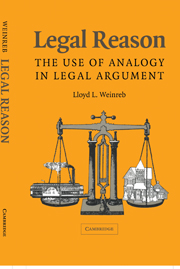Book contents
- Frontmatter
- Contents
- Preface
- Introduction
- 1 Analogy and Inductive and Deductive Reasoning
- 2 Steamboats, Broadcast Transmissions, and Electronic Eavesdropping
- 3 Analogical Legal Reasoning
- 4 Analogical Reasoning, Legal Education, and the Law
- Appendix A Note on Analogical Reasoning
- Appendix B Biographical Notes
- Notes
- Index
3 - Analogical Legal Reasoning
Published online by Cambridge University Press: 05 June 2012
- Frontmatter
- Contents
- Preface
- Introduction
- 1 Analogy and Inductive and Deductive Reasoning
- 2 Steamboats, Broadcast Transmissions, and Electronic Eavesdropping
- 3 Analogical Legal Reasoning
- 4 Analogical Reasoning, Legal Education, and the Law
- Appendix A Note on Analogical Reasoning
- Appendix B Biographical Notes
- Notes
- Index
Summary
The use of analogies in the cases discussed in Chapter 2 is strongly at odds with accounts of analogical reasoning that treat it, one way or another, as suspect: either a flawed and inadequate (even if somehow useful) substitute for the real thing or a preliminary and ultimately disposable stimulus to a sound argument, which contributes nothing to the argument's validity. In all of the cases, the court relied on analogical reasoning much more forcefully than that, as an integral part of the argument itself. Much of the discussion in the opinions is deployed to vindicate the court's reliance on one analogy rather than another. Dissenting judges express their objection to the majority's conclusion as disagreement with the analogy on which the majority relies, and they offer an alternative analogy that seems to them more persuasive. Far from analogies serving merely to illustrate or underscore an instrumental argument, such arguments from prior cases are used to explain why the analogy is a good one, and the analogy in turn supports reliance on those instrumental arguments. If the court expresses a general principle that expands on an analogy (“Broadcasters perform; viewers do not perform,” “Privacy protects people, not places”), on its own the principle is too broad to express the court's holding and requires reference to the analogy to ascertain its true scope. The direction of thought is from the analogy to the principle, rather than the other way around.
- Type
- Chapter
- Information
- Legal ReasonThe Use of Analogy in Legal Argument, pp. 65 - 122Publisher: Cambridge University PressPrint publication year: 2005



